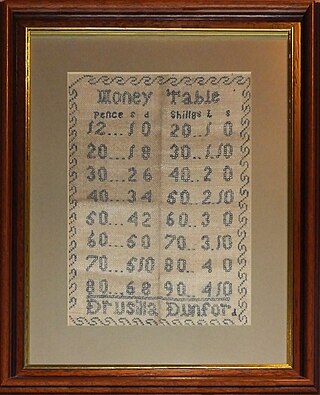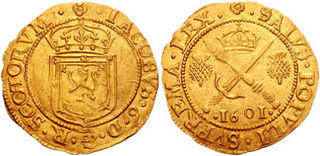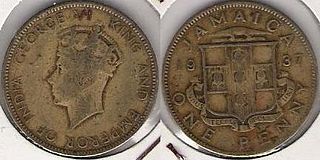Related Research Articles
The Eastern Caribbean dollar is the currency of all seven full members and one associate member of the Organisation of Eastern Caribbean States (OECS). The successor to the British West Indies dollar, it has existed since 1965, and it is normally abbreviated with the dollar sign $ or, alternatively, EC$ to distinguish it from other dollar-denominated currencies. The EC$ is subdivided into 100 cents. It has been pegged to the United States dollar since 7 July 1976, at the exchange rate of US$1 = EC$2.70.

The standard circulating coinage of the United Kingdom, British Crown Dependencies and British Overseas Territories is denominated in pennies and pounds sterling, and ranges in value from one penny sterling to two pounds. Since decimalisation, on 15 February 1971, the pound has been divided into 100 (new) pence. Before decimalisation, twelve pence made a shilling, and twenty shillings made a pound.

The British farthing abbreviated qua., was a denomination of sterling coinage worth 1/960 of one pound, 1/48 of one shilling, or 1/4 of one penny; initially minted in copper and then in bronze, which replaced the earlier English farthings. Before Decimal Day in 1971, Britain used the Carolingian monetary system, wherein the largest unit was a pound sterling of 20 shillings, each of 12 pence. Each penny was divided into 4 farthings, thus, a pound sterling contained 960 farthings, and a shilling contained 48 farthings. From 1860 to 1971, the purchasing power of a farthing ranged between 12p and 0.2p in 2017 values.

Sterling is the currency of the United Kingdom and nine of its associated territories. The pound is the main unit of sterling, and the word "pound" is also used to refer to the British currency generally, often qualified in international contexts as the British pound or the pound sterling. In British English, its most common nickname is "quid."

The pound sterling is the official currency of the United Kingdom, Jersey, Guernsey, the Isle of Man, British Antarctic Territory, South Georgia and the South Sandwich Islands, and Tristan da Cunha.

£sd is the popular name for the pre-decimal currencies once common throughout Europe, especially in the British Isles and hence in several countries of the British Empire and subsequently the Commonwealth. The abbreviation originates from the Latin currency denominations librae, solidi, and denarii. In the United Kingdom, these were referred to as pounds, shillings, and pence.
The British West Indies dollar (BWI$) was the currency of British Guiana and the Eastern Caribbean territories of the British West Indies from 1949 to 1965, when it was largely replaced by the East Caribbean dollar, and was one of the currencies used in Jamaica from 1954 to 1964. The monetary policy of the currency was overseen by the British Caribbean Currency Board (BCCB). It was the official currency used by the West Indies Federation The British West Indies dollar was never used in British Honduras, the Cayman Islands, the Turks and Caicos Islands, the Bahamas, or Bermuda.

The pound was the currency of Scotland prior to the 1707 Treaty of Union between the Kingdom of Scotland and the Kingdom of England, which created the Kingdom of Great Britain. It was introduced by David I, in the 12th century, on the Carolingian monetary system of a pound divided into 20 shillings, each of 12 pence. The Scottish currency was later devalued relative to sterling by debasement of its coinage. By the time of James III, one pound Scots was valued at five shillings sterling.

The Jamaican dollar has been the currency of Jamaica since 1969. It is often abbreviated to J$, the J serving to distinguish it from other dollar-denominated currencies. It is divided into 100 cents, although cent denominations are no longer in use as of 2018. Goods and services may still be priced in cents, but cash transactions are now rounded to the nearest dollar.
The pound is the currency of the Isle of Man, at parity with sterling. The Manx pound is divided into 100 pence. Notes and coins, denominated in pounds and pence, are issued by the Isle of Man Government.
The Saint Helenapound is the currency of the Atlantic islands of Saint Helena and Ascension, which are constituent parts of the British Overseas Territory of Saint Helena, Ascension and Tristan da Cunha. It is fixed at parity with sterling, and so both currencies are commonly accepted and circulated within Saint Helena. It is subdivided into 100 pence.
The pound is the currency of the Falkland Islands, a British Overseas Territory in the South Atlantic Ocean. The symbol is the pound sign, £. The ISO 4217 currency code is FKP.
There have been three sets of coins in Ireland since independence. In all three, the coin showed a Celtic harp on the obverse. The pre-decimal coins of the Irish pound had realistic animals on the reverse; the decimal coins retained some of these but featured ornamental birds on the lower denominations; and the euro coins used the common design of the euro currencies. The pre-decimal and original decimal coins were of the same dimensions as the same-denomination British coins, as the Irish pound was in currency union with the British pound sterling. British coins were widely accepted in Ireland, and conversely to a lesser extent. In 1979 Ireland joined the Exchange Rate Mechanism and the Irish pound left parity with sterling; coin designs introduced after this differed between the two countries.
The British farthing was a British coin worth a quarter of an old penny. It ceased to be struck after 1956 and was demonetised from 1 January 1961.
Irish coins have been issued by a variety of local and national authorities, the ancient provincial Kings and High Kings of Ireland, the Kingdom of Ireland (1541–1801), the United Kingdom of Great Britain and Ireland (1801–1922), the Irish Free State (1922–1937), and the present Republic of Ireland. Since 2002, the Republic of Ireland has minted Euro coins, featuring symbols such as flax and the harp.

The pound was the official currency of Jamaica between 1840 and 1969. It circulated as a mixture of sterling coinage and locally issued coins and banknotes and was always equal to the pound sterling. The Jamaican pound was also used in the Cayman and Turks and Caicos Islands.
British Pobjoy Mint is a privately held company-sector mint located in Surrey, England, which produces commemorative coins, medal, tokens and bullion. The mint also manufacturers circulating currency for some British Overseas Territories and sovereign countries including Sierra Leone and Vanuatu.
The region known as the British West Indies included British Guiana on the South American mainland, British Honduras in Central America, Bermuda, The Bahamas, and Jamaica, along with its former dependencies of the Cayman Islands and the Turks and Caicos Islands. It also included the Eastern Caribbean territories of Trinidad and Tobago, Barbados, the Windward Islands and the Leeward Islands.

Saint Helena, Ascension and Tristan da Cunha is a British Overseas Territory located in the South Atlantic and consisting of the island of Saint Helena, Ascension Island, and the archipelago of Tristan da Cunha. Its name was Saint Helena and Dependencies until 1 September 2009, when a new constitution came into force giving the three islands equal status as three territories, with a grouping under the Crown.
Sterling was the currency of many, but not all parts of the British Empire. This article looks at the history of sterling in the Australia, New Zealand, and Pacific region.
References
- ↑ "Falkland Islands". Banknote World. Retrieved 21 February 2023.
- ↑ "Stamps & Coins of the Falkland Islands". The Falkland Islands Association. Retrieved 21 February 2023.
- ↑ Coins: South Georgia and the South Sandwich Islands, at British Pobjoy Mint, accessed 14 August 2020.